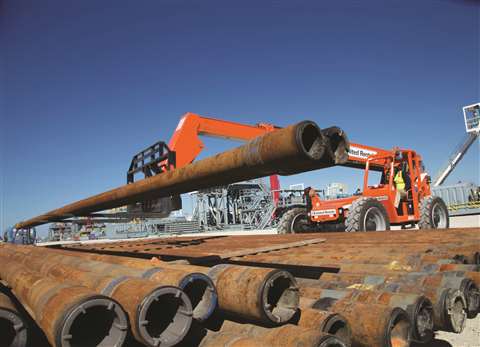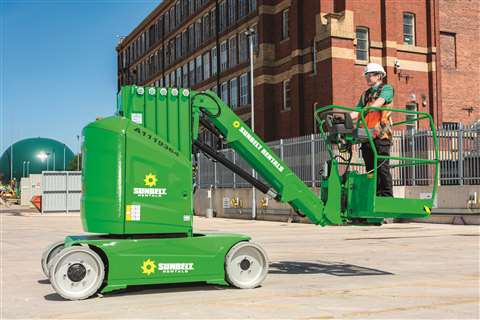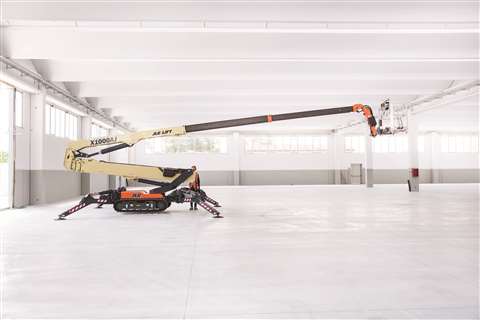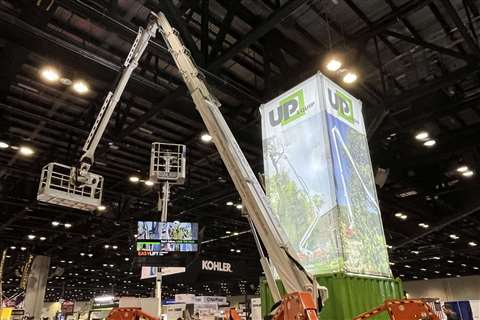Why the North American equipment market is growing in both confidence and complexity
24 April 2023
The economy is strong in North America, particularly in the US, as is the demand for access equipment.
 United Rentals has recently acquired access major Ahern Rentals. (PHOTO: United Rentals)
United Rentals has recently acquired access major Ahern Rentals. (PHOTO: United Rentals)
While the economy remains resilient on the continent, and in the US especially, one thing getting in the way are the lead times for equipment, with companies still reporting record backlogs.
Despite indications things may be improving through work carried out to optimise production and relationships with suppliers, it may take the rest of this year or longer to correct.
The American Rental Association (ARA) is striking a word of caution. Following 2022’s vibrant equipment rental markets across the US and Canada, experts speaking on behalf of the association at February’s ARA Show said construction and industry should prepare for limited revenue and growth this year.
“There’s no joy coming out of the housing market this year,” says Scott Hazelton, director, S&P Global Market Intelligence. “We’re not out of the woods yet.”
Hazelton and John McClelland, ARA’s vice president for government affairs and chief economist, predicted a slight recession for the first and second quarters of this year, noting the federal government will again raise rates, most likely related to inflation. Canada will also feel the impact of inflation and experience a slight recession.
How the United States’ IIJA Infrastructure Bill will affect the access equipment market
While the United States’ IIJA Infrastructure Bill, introduced in 2021, is set to inject up to US$1.5 billion (£1.2 billion) into related projects, its impact will not be fully felt until 2024 – even then, the industry will only see 1.9% growth for construction and industrial rental. Peak spending related to IIJA work won’t surface until 2025, both economists noted.
Despite these ripples, the long-term market, particularly in the US, is looking positive. Following JLG’s 2022 full year results, parent company Oshkosh’s president and CEO John Pfeifer said demand remains “very strong” for JLG products and is being driven by “strong utilization rates, elevated fleet ages and the large number of mega projects underway across the United States. “
 Sunbelt Rentals continues on its acquisition strategy. (PHOTO: Sunbelt Rentals)
Sunbelt Rentals continues on its acquisition strategy. (PHOTO: Sunbelt Rentals)
In fact, the percentage of access equipment in rental fleets deployed on mega projects, which are generally defined as projects with a value of $400 million or more, has more than doubled over historical levels.
“We expect that mega projects, including factories for EVs, batteries and chips as well as non-residential projects such as data centers and healthcare facilities will continue to contribute to strong demand for our equipment for the foreseeable future.
Ashtead, Sunbelt’s parent company, is increasing its capital investment this financial year to US$3.5-3.7 billion – slightly ahead of its previous guidance – and will further accelerate this in 2023/24.
Consolidation also continues at pace in the market. A recent major acquisition in the US was that of Ahern Rentals by United Rentals earlier this year.
A commonly held view is that while this was no doubt perfect timing for owner Don Ahern to sell the business he had built over decades, it was also an opportunity for United Rentals to add much-needed equipment to its fleet.
How manufacturers are coping with the ongoing China-US trade war
Returning to the subject of manufacturers, those based in China have been heavily affected by the tariffs imposed last year on their MEWPS on entering the US.
However, this has not stopped them from seeking business in the country and looking at ways around the issue.
A solution being adopted by some of those manufactures is to build factories in Mexico, where labour is also less expensive. There remains a requirement for a reasonable percentage of components to be produced locally, rather than bringing them in from China, or other countries in North America. However, companies believe it is worth the investment to make trading in the US effective.
LGMG is opening its Mexico plant in the third quarter of this year and will start supplying equipment to North America in March. The company is also relocating its head office from Pennsylvania to Dallas, bringing it closer to the Mexico plant.
At the ARA Show, the company explained that it had to restructure its entire supply chain in reaction to the US tariffs. “The tariffs stopped everyone from the Chinese manufacturers. This plan will bring us back to the US market.”
The production line will cover the manufacturer’s complete range of MEWPs and long-term will have a capacity of 25,000 units.
 JLG has completed its acquisition of Italy’s Hinowa. (Photo: JLG)
JLG has completed its acquisition of Italy’s Hinowa. (Photo: JLG)
While LGMG has sold equipment to United Rentals, a major aim will be the vast number of small and middle-sized rental companies across the US.
It must be noted that Mexico has also been identified as a more cost-effective solution by North America-based manufacturers, including Genie and Skyjack which have set up major facilities in the country.
Why ‘mom and pop’ rental businesses will suffer the most under financial pressures
One issue pointed out by Italian manufacturer CTE Lift, which is seeking to expand sales in North America, is the rising interest rates; a factor being experienced around much of the world, combined with the extra cost of borrowing and energy.
This has had a particularly detrimental effect on very small ‘mom & pop’ rental companies, which don’t have the financial reserves or backing of the larger companies.
How European spider lifts are taking on the US market
Once a very niche product in North America, the spider lift is still relatively new to the market but has seen significant success over recent years, particularly in the core area of arborist applications.
However, the value of these lightweight versatile machines is also increasingly being recognised in other industries, such as maintenance, construction and the rental sector. And the potential in North America is further highlighted by the fact that for many of these manufacturers the US is already their number one market in terms of sales.
An indication of the growing value placed on spider lifts in the US lies in JLG’s acquisition of Italian spider specialist Hinowa, which was completed earlier this year.
The drive by European spider lift manufacturers into North America, is also evident in the activities of European manufacturers’ own subsidiaries and distributors, and in their medium and long term manufacturing strategies.
With moves being made by CMC, Ommelift, Platform Basket, Easy Lift, Imer USA, Teupen, Spimerica and CTE North America, AI provides a more detailed overview of how European spider lifts manufacturers are capitlising on opportunities in North American market:
STAY CONNECTED



Receive the information you need when you need it through our world-leading magazines, newsletters and daily briefings.
CONNECT WITH THE TEAM









